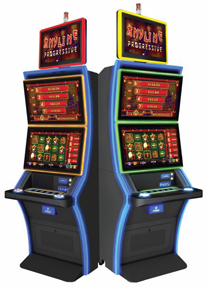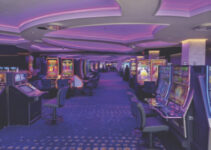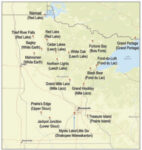
The history of Class II electronic bingo under the Indian Gaming Regulatory Act of 1988 is one of conflict. Originally introduced as an “electronic enhancement” of traditional bingo under IGRA’s Class II rules, electronic bingo machines would evolve through an effort by suppliers to multiply potential bingo-card patterns and work the math, displaying bingo results as the reel results in games that looked identical to the slot machines in commercial casinos.
Pioneering tribes, notably the Seminole Tribe of Florida, showcased Class II slot machines during the 1990s as the technology improved to make them appear more slot-like. The Seminoles’ expanding use of Class II games ultimately led the tribe into legal roadblocks, including a 1996 lawsuit by the state of Florida attempting to enjoin the Seminoles from offering the games, which the state claimed were in reality “electronic or electromechanical facsimiles of games of chance,” prohibited under Class II of IGRA.
While that particular lawsuit was dismissed on tribal immunity grounds, the Seminoles and other tribes would win subsequent legal and bureaucratic battles over the nature of Class II electronic bingo machines, including an extended battle with the National Indian Gaming Commission, the federal agency overseeing Indian gaming. Former NIGC Chairman Philip Hogen spent much of his 2002-2009 tenure attempting to establish technical standards for Class II that would draw what he called a “bright line” distinguishing Class II games from Class III casino slots.
Some of those standards were the very elements preventing Class II from enjoying earnings approaching Class III slots—such as a rule requiring multiple “touches” by the player to complete each play on the slot, simulating the “daubing” of a bingo card. As his term was nearing its end in 2008, Hogen announced that NIGC was dropping the most controversial standards initially proposed for Class II games, including multiple touches.
Ironically, by that time, the Seminoles had moved on to Class III, negotiating a compact with Florida that was finalized in 2010, giving the tribe the right to offer Class III slot games. Across the country in California, a few other of the most successful gaming tribes in the U.S. were earning profits mainly from compacted Class III slot machines—which had been deemed a necessity as the young California tribal industry competed with nearby Nevada.
Meanwhile, game developers working for leading suppliers of both Class II and Class III slot machines refined the technology and game math, allowing Class II slot games to perform and play ever closer to the game experience provided by their Class III counterparts.
Today’s Class II market is served not only by a few longtime Class II stalwarts, but by a collection of well-capitalized suppliers that benefited from major mergers and acquisitions. The former Global Cash Access merged with traditional Class II supplier (and fast-growing Class III company) Multimedia Games to form Everi; AGS acquired veteran Class II supplier Cadillac Jack. Slot giant Aristocrat acquired Tennessee-based Class II company VGT.
The resulting financially powerful companies have joined large suppliers like IGT and Scientific Games, which have long supplied Class II Native American markets, and smaller but well-established Class II suppliers such as Georgia’s Eclipse Gaming, in steadily improving the technology of Class II to the point where the two styles of games are now more similar than ever.
“It’s tremendous what’s happened over the last five years,” says Andrew Burke, senior vice president of slot products for AGS. “Everything, from internet speed—because everything is linked up—is just so much faster than it was 10 years ago. The ability to port complex math models from Class III into Class II, and to create Class II unique math models, shows that the technology has really opened up. The game play itself is almost indistinguishable. If you put a bank of Class II games in the middle of a floor of Class III games, in a market that’s never had Class II, a player would never know the difference.”
“I’ve been in Class II probably 18 years, and yes, (technology) has narrowed the gap,” says Tim Minard, CEO of Eclipse Gaming. “There have been significant improvements in technology. Class II has evolved into high-performing entertainment.”
Knute Knudson, who was a South Dakota lawmaker when IGRA was passed, joined International Game Technology in 1992 as vice president specializing in serving Native American markets. Over his 27 years at IGT, Knudson has witnessed the entire evolution of the Class II gaming machine. He says IGT and other suppliers have “closed the gap” in game play between Class II and Class III “unequivocally.”
“Some of the best ways to demonstrate that are play functionality, and specifically, game speed,” Knudson says. “For example, our Class II game will complete a play cycle in 2.5 seconds, which is exactly the play cycle for a Class III game.”
Adding Class II
The evolution of Class II technology has provided content for a growing market, as even tribes in markets that allow both Class II and Class III are increasing Class II in their game mix.
“Markets like Oklahoma that have had Class II continue to add it,” says Burke at AGS. “And there’s a mandate that any part of their floor should be at least 50 percent Class II. The new markets are starting to try it that haven’t historically tried it—markets like Arizona, Indiana, the new Four Winds property—and we’re hearing about a lot of new projects like that. They’re actually trying Class II for the first time in a lot of cases, which I think is great.”
“And you find interest in just about all jurisdictions,” adds IGT’s Knudson. “There’s a variety of reasons for that, the first of which is, of course, the quality of the Class II, and the machine performance.”
Jesse DeBruin, senior vice president of gaming operations for Everi Holdings, notes that while Class II growth is not evident in all markets that include both classifications, the industry overall is increasing its footprint of Class II games.
“In California over the past two-plus years, the majority of those tribes have renegotiated their compacts, and a lot of those tribes have reduced or eliminated our Class II footprint,” DeBruin says, citing state removals of caps on Class III games as the primary reason.
“However, we’re also seeing a lot of new Class II-only facilities go up,” he says. “You have Four Winds in Indiana. You have Texas casinos, you have Alabama casinos. You also have a lot of states where they consider Class II a significant part of the roadmap, and they want to continue to expand and grow Class II.”
Minard of Eclipse Gaming, a longtime Class II supplier with presence in some Class III markets, says the growth of Class II is not over. “I believe that Class II will become continually more relevant,” he says, “as we continue to come up with more exciting and different games for that market.
“The advantage of Class II is that there’s a ton of titles out there; everybody’s developing, and there’s a lot of familiarity. But not every one of those games has a Class II version.”
There is, in fact, still much more variety in Class III game libraries, which is why tribes in markets like California and Florida continue to add them. However, James Starr, president of VGT, says Class II suppliers are working diligently to close the gap.
“We have an opportunity to expand Class II hardware and content to provide variety similar to that available in Class III,” Starr says. “We as well as other manufacturers are slowly making progress toward delivering more of the form factors and content for Class II. Now, Class II options are better, and technology is definitely better.
“Historically, Class II technology and products have been perceived as inferior. Some in the industry have caught on to the fact that the technology has advanced rapidly, particularly in the last three or four years.”
He says the acquisitions have fueled the acceleration of development on the Class II side. “Some people perceive that Class II is still where it was 10 to 12 years ago. That’s one of the things we’ve had to work hard to overcome, historical expectations, and it’s our biggest challenge going forward.”
Class II vs. Compacts
Although technological advancement has made the play experiences of Class II and Class III nearly identical, gaming tribes in many states where both classifications are authorized still lean on the traditional Class III games. That may be changing, but compacted tribes are sure to continue to take full advantage of the ability to offer any and all new slot games from the major suppliers, not to mention a full complement of table games.
In addition to variety, Minard of Eclipse Gaming notes that while very close, Class II games are not yet identical in play to traditional Class III slots. “The speed in which you can do the ball calls and bingo results has created just a nominal speed difference,” he says. “I think the math models are still a little bit different, but bingo still has a finite amount of outcomes. So, there are things you can do with Class III that are maybe a bit more challenging with Class II.”
One more difference that is not normally noticed at the larger casinos but is still a Class II rule: At least two players must be active for a Class II bingo game to proceed, so on a near-empty floor, a Class II machine may pause after the spin button is pushed to wait for another player to join the server-based bingo game.
Minard stresses, though, that improvements in processing speed are all but wiping those differences out, from the player’s perspective. The evolution of Class II has made them a viable substitute for Class III where both classifications are available, he says.
VGT’s Starr offers Oklahoma as a prime example, where there is significant Class II growth in what he estimates is the largest hybrid Class II/Class III market today. “We have seen a trend the last few years in Oklahoma where it’s crept up from around 40 percent Class II to over 45 percent today,” he says. “You also are starting to see some markets like California and Washington add some Class II—not at the rates you’re seeing in Oklahoma, but even in some states like Wisconsin, you’re seeing some Class II, more as a trial. As we become successful, I’m sure they’ll add more.”
The value of Class II to gaming tribes in hybrid jurisdictions lies not only in their play and earning power, but in the leverage they give tribes in negotiations when it comes time to renew Class III gaming compacts. After all, there is no revenue sharing for Class II games, so the closer the play experience comes to Class III, the more viable it is to load a slot floor with Class II and pay nothing to the host state.
“There are active compact negotiations in a number of jurisdictions,” says IGT’s Knudson. “Negotiations continue in Oklahoma. Some major markets expire very soon. Class II is an extremely important negotiating tool, because compacts obviously are not necessary for Class II products to be utilized.”
“I’m watching tribes go through (negotiations) right now in Oklahoma,” says AGS’ Burke. “I can tell you Class II gives them that leverage, because they are 100 percent serious about going all Class II if they don’t get what they want.
“The tribes have been able to look at the states with a straight face and say, ‘Hey, if you don’t want to negotiate with us and play ball with us, we’ll just go this other route.’ I think that’s why it’s important to them that they keep 50 percent of their floor in Class II, in case they need to make a switch fast.”
Accelerating Game Development
The growth of Class II—and the refinement of bingo math models to the point where play is nearly identical to Class III—has led to parallel efforts in game research and development as suppliers strive to fill the gap in available content between the two classifications.
All of the suppliers serving both classifications now design new games to be launched in both classes simultaneously, as well as new games specifically tailored to Class II and customers in specific markets.
DeBruin says Everi devotes its efforts to creating content that will earn in either class. “It’s something we’ve prided ourselves on, in terms of our approach with our tribal partner customers,” he says. “We do not have separate development teams. We design a game with Class II operators in mind, and then release it, across Class II and Class III. That allows us to leverage our game design in all markets. It gives us flexibility.”
Burke says AGS follows the same procedure, on the slot platform the company developed on the bones of the operating system it inherited from the former Class II-heavy Cadillac Jack. VGT’s Starr, similarly, says all Class II development is now under the same Aristocrat team that produces Class III titles.
Knudson says IGT designs class II-specific content, along with Class III content that can be ported over to Class II. “We’re putting a lot of the very successful games from Class III into Class II, and we’re also designing very specific games just for Class II,” he says.
One result of all this new R&D effort is a growing library of products that follow the same trends as the Class III market. Lately, that means progressive slots. All the manufacturers are proliferating the progressive footprint in Class II markets, particularly in the area of local-area progressives.
“What you’re seeing more and more now is technology where there’s not only the wide-area progressive, but you’re also seeing the single-site local-area progressives,” says VGT’s Starr. “And those tend to be the games players want to play the most. Particularly, we’re seeing a trend toward those single-site progressives because they tend to hit more frequently.”
Many of the progressives now in the Class II market are in the style of multiple progressives popular in Class III markets right now. “I think the shift to multi-level progressives in Class II is really driven more by the shift of progressives in general,” comments Burke. “The whole gaming market has shifted that way, to the point where if you don’t have games with progressives, you’re in trouble.”
As in Class III, there is plenty of room for innovation in the Class II market. Eclipse Gaming, for instance, offers an “Anyline Progressive” that awards players regardless of the pay line on which a winning progressive lands. “Entertainment obviously is becoming a little more of a factor in Class II,” says Minard. “You see bigger splash, bigger cabinets, more unique cabinets, better lights, better graphics… The math still makes such a difference, but the visual aspects of these games are improving more and more.”
The acceleration of Class II content introduction is supported by the same R&D efforts that support the Class III libraries of all manufacturers—small suppliers like Eclipse as well as the industry leaders. “We do player focus groups,” Minard says, “and we have advisory councils that include players, but mostly consist of slot directors from around the country. We do that regularly; we’re always soliciting feedback.
“And being small, we can be nimble. We’ve been in business 10 years, and we’ve earned a good share of the marketplace. We’ve got over 100 titles, and we have a good stable base of customers that like to play our games.”
The larger, post-merger companies like Everi and AGS, while combining design efforts and growing in Class III markets, mirror that same attitude of managing their market share, their legacy companies having served Class II markets for decades.
“For a company like ours that started as a Class II company, we have a design philosophy in mind, where we’re designing for Class II and Class III customers together,” says DeBruin. “Suppliers that started as Class III might not have the same approach. Everything we offer in Class III, for the most part, we offer in Class II. That’s not always the case with other manufacturers.
“So, I think casinos will continue to look for both Class II and Class III, where they can. I think Class II is certainly here to stay, long-term. I think it’s going to continue to be of critical importance to tribes. It really allows them to maintain their independence… You still have some jurisdictions out there and some states out there that have zero compacts, and it’s purely Class II—Texas, Alabama—so, from a macro level, Class II will continue to be of critical importance to customers.”
“Class II will continue to grow as a percentage of the overall slot product,” agrees IGT’s Knudson. “While I don’t think you will see double-digit increases on an annual basis, I think it’s possible we could see increases on an annual basis in Class II.”
“We were happy to see a few Class II-only properties opening up just in this last year, like Four Winds South Bend in Indiana and Prairie Flower in Iowa,” adds VGT’s Starr. “While there is an expansion of Class II-only properties, we have seen more Class III facilities giving Class II a trial. As we continue to improve Class II quality, more Class III properties continue to add Class II games.”
“I think there’s still this stigma and this thought that technology in Class II is old and antiquated,” says Burke at AGS, “so, I think a lot of people just aren’t aware of how far it’s come.
“I see it growing. I see it becoming a way for tribes to expand their businesses. I think you should see big California operators start to explore smaller Class II facilities on their reservations. The technology is there to do that. The business is there to do that. So, I think that as they mature their businesses, Class II is a natural way to grow it.”















